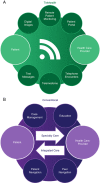Medical and Behavioral Approaches to Engage People Who Inject Drugs Into Care for Hepatitis C Virus Infection
- PMID: 28701904
- PMCID: PMC5491232
- DOI: 10.1097/ADT.0000000000000104
Medical and Behavioral Approaches to Engage People Who Inject Drugs Into Care for Hepatitis C Virus Infection
Abstract
Direct-acting antivirals for hepatitis C virus infection may revolutionize treatment among persons with substance use disorders. Despite persons with substance use disorders having the highest hepatitis C virus prevalence and incidence, the vast majority have not engaged into care for the infection. Previously, interferon-based treatments, with substantial side effects and the propensity to exacerbate mental health conditions, were major disincentives to pursuit of care for the infection. Direct-acting antivirals with viral eradication rates of >90%, significantly improved side effect profiles, and shorter treatment duration are dramatic improvements over prior treatment regimens that should promote widespread hepatitis C virus care among persons with substance use disorders. The major unmet need is strategies to promote persons with substance use disorders engagement into care for hepatitis C virus. Although physical integration of treatment for substance use and co-occurring conditions has been widely advocated, it has been difficult to achieve. Telemedicine offers an opportunity for virtual integration of behavioral and medical treatments that could be supplemented by conventional interventions such as hepatitis C virus education, case management, and peer navigation. Furthermore, harm reduction and strategies to reduce viral transmission are important to cease reinfection among persons with substance use disorders. Widespread prescription of therapy for hepatitis C virus infection to substance users will be required to achieve the ultimate goal of global virus elimination. Combinations of medical and behavioral interventions should be used to promote persons with substance use disorders engagement into and adherence with direct-acting antiviral-based treatment approaches. Ultimately, either physical or virtual colocation of hepatitis C virus and substance use treatment has the potential to improve adherence and consequently treatment efficacy.
Keywords: HCV; HCV treatment; persons with substance use disorders.
Figures


Similar articles
-
Hepatitis C virus control among persons who inject drugs requires overcoming barriers to care.World J Gastroenterol. 2013 Nov 28;19(44):7846-51. doi: 10.3748/wjg.v19.i44.7846. World J Gastroenterol. 2013. PMID: 24307778 Free PMC article. Review.
-
'Treat my whole person, not just my condition': qualitative explorations of hepatitis C care delivery preferences among people who inject drugs.Addict Sci Clin Pract. 2021 Aug 12;16(1):52. doi: 10.1186/s13722-021-00260-8. Addict Sci Clin Pract. 2021. PMID: 34384494 Free PMC article.
-
Eligibility of persons who inject drugs for treatment of hepatitis C virus infection.World J Gastroenterol. 2014 Sep 28;20(36):12722-33. doi: 10.3748/wjg.v20.i36.12722. World J Gastroenterol. 2014. PMID: 25278674 Free PMC article. Review.
-
Modeling indicates efficient vaccine-based interventions for the elimination of hepatitis C virus among persons who inject drugs in metropolitan Chicago.Vaccine. 2019 May 1;37(19):2608-2616. doi: 10.1016/j.vaccine.2019.02.081. Epub 2019 Apr 5. Vaccine. 2019. PMID: 30962092 Free PMC article.
-
Gaps in hepatitis C virus prevention and care for HIV-hepatitis C virus co-infected people who inject drugs in Canada.Int J Drug Policy. 2022 May;103:103627. doi: 10.1016/j.drugpo.2022.103627. Epub 2022 Feb 24. Int J Drug Policy. 2022. PMID: 35218989
Cited by
-
Update on global epidemiology of viral hepatitis and preventive strategies.World J Clin Cases. 2018 Nov 6;6(13):589-599. doi: 10.12998/wjcc.v6.i13.589. World J Clin Cases. 2018. PMID: 30430114 Free PMC article. Review.
-
Barriers to Hepatitis C Treatment and Interest in Telemedicine-Based Care Among Clients of a Syringe Access Program.Open Forum Infect Dis. 2024 Feb 13;11(3):ofae088. doi: 10.1093/ofid/ofae088. eCollection 2024 Mar. Open Forum Infect Dis. 2024. PMID: 38464492 Free PMC article.
-
HCV-infected individuals have higher prevalence of comorbidity and multimorbidity: a retrospective cohort study.BMC Infect Dis. 2019 Aug 23;19(1):712. doi: 10.1186/s12879-019-4315-6. BMC Infect Dis. 2019. PMID: 31438873 Free PMC article.
-
Can Telemedicine Optimize the HCV Care Cascade in People Who Use Drugs? Features of an Innovative Decentralization Model and Comparison with Other Micro-Elimination Strategies.Biology (Basel). 2022 May 24;11(6):805. doi: 10.3390/biology11060805. Biology (Basel). 2022. PMID: 35741326 Free PMC article. Review.
-
Hepatitis C Virus Infection in Persons Who Inject Drugs in the Middle East and North Africa: Intervention Strategies.Viruses. 2021 Jul 14;13(7):1363. doi: 10.3390/v13071363. Viruses. 2021. PMID: 34372569 Free PMC article. Review.
References
-
- Mohd Hanafiah K, Groeger J, Flaxman AD, et al. Global epidemiology of hepatitis C virus infection: new estimates of age-specific antibody to HCV seroprevalence. Hepatology. 2013;57:1333–1342. - PubMed
-
- Chak E, Talal AH, Sherman KE, et al. Hepatitis C virus infection in USA: an estimate of true prevalence. Liver Int. 2011;31:1090–1101. - PubMed
-
- Colvin HM, Mitchell AE. Hepatitis and liver cancer: a national strategy for prevention and control of hepatitis B and C. 2010. Available at: www.cdc.gov/hepatitis/pdfs/iom-hepatitisandlivercancerreport.pdf. Accessed January 22, 2017.
LinkOut - more resources
Full Text Sources
Other Literature Sources
